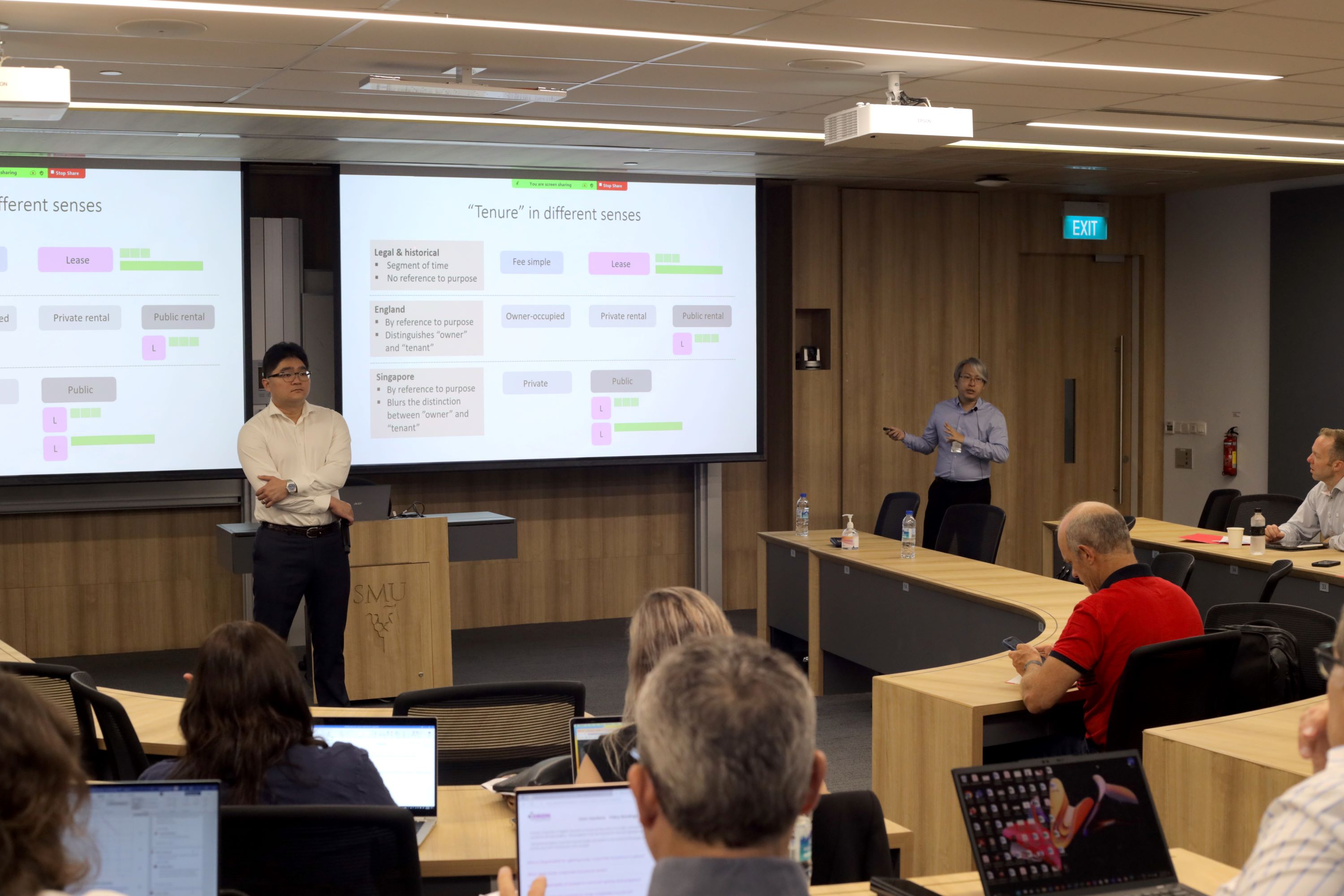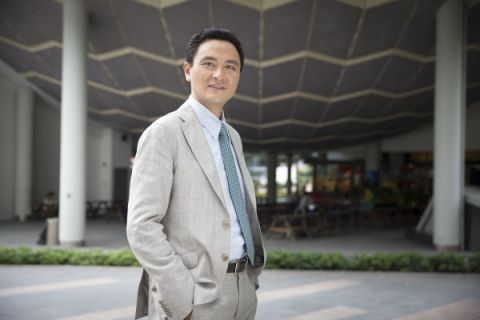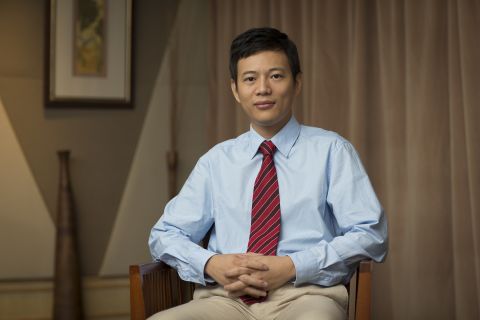
SMU Assistant Professor of Law Edward Ti (left) and SMU Associate Professor of Law (Education) Alvin See (right) presenting their work on “Promoting Diversity in High-Rise Dwellings: A Comparative Perspective”.
By Jill Arul
SMU Office of Research – Multi-family dwellings are an inevitable part of cities around the world. With so many living in close proximity to one another, conflicts are unavoidable. It is therefore important to ensure that such conflicts are efficiently resolved, and multi-family dwellings are governed properly. In the context of Singapore, applying for a high-rise public housing flat is a major, and uniquely-Singaporean, step that a large majority of local young couples take together. The decision to live in tightly-packed public housing is one born of necessity in an island where 5.5 million people live in 1.4 million homes and make up the third most dense country in the world.
In fact, in Singapore, 78 per cent of the total housing stock is high-rise public housing. This reality is starkly different from nations like the United Kingdom (UK) where 77 per cent of homes are houses and just 22.7 per cent are – mostly low-rise – flats. At the 18th Annual Australian College of Strata Lawyers (ACSL) Strata Law Conference recently hosted by the Yong Pung How School of Law, more than 50 legal experts – academics and practitioners alike – from Singapore, Australia, New Zealand, UK, Canada and Israel explored the differences between and nuances within strata and multi-family living across jurisdictions.
Rising diversity in high-rise living
Assistant Professor of Law Edward Ti and Associate Professor of Law (Education) Alvin See of the Singapore Management University (SMU) opened the second day of the conference with a presentation on their work surrounding diversity in high-rise dwellings. Specifically, their work focuses on differing policies in two diverse nations – Singapore and the UK.
In Singapore, Professor Ti explained to attendees, affordable public housing aims to promote racial diversity through the Ethnic Integration Policy (EIP). The policy was introduced in 1989 to prevent racial enclaves from forming and enforces racial quotas at the purchase and resale of a flat. It requires flat owners to sell to members of their same ethnicity in the resale market.
Over the years, the policy has been generally well supported albeit with some mixed responses. While it has achieved its goal of encouraging social cohesion, it was reported to Parliamentarians that some minority Singaporeans face difficulty when trying to sell their flat and may reap a lower profit than their majority counterparts.
While public housing makes up a large proportion of homes in Singapore, in the UK, just 16.5 per cent of homes are considered public housing and the classification within this group is slightly more complicated. These homes are run by local authorities, housing associations or other private registered providers and offer social rent, affordable rent and low-cost ownership options. As he explained further, Professor See pointed out that while the UK is incredibly diverse, the focus is on avoiding discrimination rather than creating cohesion.
“As far as ethnic integration policies are concerned, they have quite a difficult path because discrimination has been a problem,” said Professor See. “Especially from the 1960s to the 2000s when there was a huge influx of migrants from former British colonies, research has shown the prevalence of discrimination in the housing sector.”
While there have been improvements, like the 2000 amendment to the Race Relations Act that empowered public authorities to prohibit discrimination, Professors See and Ti suggest that reclassifying public housing in the UK could help authorities implement policies that promote racial cohesion. Currently, public housing that is purchased by the tenant in the UK becomes private property – this is not the case in Singapore and allows governing bodies to enforce requirements for sale and purchase like the EIP.
The place of children in multi-owned dwellings

SMU Professor of Law Tang Hang Wu sharing about his work on “The Law and Children in Multi-Owned Buildings”.
Further exploring the interests of different groups living in multi-owned buildings, SMU Professor of Law Tang Hang Wu sparked a conversation surrounding his work comparing the law between Singapore and New South Wales on how the law protects children in such homes. Children’s interests do not fit within the paradigm of majority versus minority interests which leaves them trapped into a “vulnerability complex” cycle in need of protection by adults and adult institutions.
If the majority cannot be trusted to act in ways that are not detrimental to health and safety of children, Professor Tang suggested a rights-based discourse rooted in the United Nations Convention on Rights of the Child to resolve such issues where the health and safety of children are at risk. Apart from a rights-based discourse, Professor Tang’s paper conceptualises the legal relations embedded within multi-owned housing and the various theories of property ownership to determine how children’s interests fit within this framework. Drawing on pluralist moral theories of property law, Professor Tang’s argument is that children’s issues within multi-owned housing should not be subject to majoritarian rule especially when their health and safety is at stake.
For example, the majority of owners in multi-owned housing may not support the installation of grilles in some apartments even though this is done at the apartment owners’ own cost because they fear such grilles would detract from the uniform appearance of the building. This results in an increased risk of children falling from windows or balconies. Professor Tang explained that according to New South Wales’ model by-laws, security measures like grilles are automatically permitted in the name of safety. However, this would not apply to developments that do not adopt the relevant model by-laws.
In Singapore, while the legislative changes were made later than in Australia, an existing statute was amended to explicitly allow safety devices that protect children. Even before such legislative changes, reported case law showed that the importance of protecting children took precedence over other concerns like uniformity and common area rules.
“Ultimately, I think that the statute used both in Singapore and Australia do exhibit some protective principle, which I think is correct,” shared Professor Tang. “I end with saying that I think this issue can be easily solved by parliament and I think legislation should do more.”
By adjusting existing legislation around problems that people face in their daily lives, legal systems can help citizens truly thrive in their homes.
The conference took place between 1st and 3rd March 2023 and presenters were invited to submit their papers for consideration for a special issue of the Journal of Property, Planning Law and Environment (JPPEL). SMU Assistant Professor Edward Ti is the guest editor of the special issue which is slated to be published later this year.
Back to Research@SMU May 2023 Issue
See More News
Want to see more of SMU Research?
Sign up for Research@SMU e-newslettter to know more about our research and research-related events!
If you would like to remove yourself from all our mailing list, please visit https://eservices.smu.edu.sg/internet/DNC/Default.aspx

